Dehydration is far and away my favorite method of preserving tomatoes due to several advantages.
- The final product requires little storage space.
- If done correctly, dehydration preserves the nutritional value of the tomatoes.
- If dried plain (without oil, fresh garlic, or fresh herbs), it’s an uber safe method for long term storage.
- It’s ridiculously easy – so easy that it seems hardly worthy of a post. Yet there are a few things I’ve learned, which might be helpful, if you don’t already know how to dry tomatoes.
I use a Nesco food dehydrator and jerky maker with 4 tiers. Check out a few different dehydrators, or scroll down for the 6 Tips.
6 Tips for drying tomatoes
1. Use “meaty” tomatoes
Plum tomatoes have relatively less water and more flesh, resulting in more material when dried. You can however, dry any variety. Some years I grow only standard type tomatoes, because none of the varieties of plum tomatoes I’ve grown produce nearly as well in my garden. I find that Early Girl produces an abundance of medium sized fruits which are meatier than many other varieties. The worst tomatoes for drying (most watery) are, in my experience, the big beef steak type. There’s almost nothing left after drying them.
2. Remove the skin from the bottom end
You already know to remove the scar at the stem end. But you should also cut a thin slice off the opposite end and discard it. It takes forever for this piece to dry, because the skin limits evaporation. And when it does dry, there’s nothing left but a flake of skin. So don’t waste space in the evaporator. Toss ’em out to the chickens and they’ll turn ’em into compost for next year’s garden.
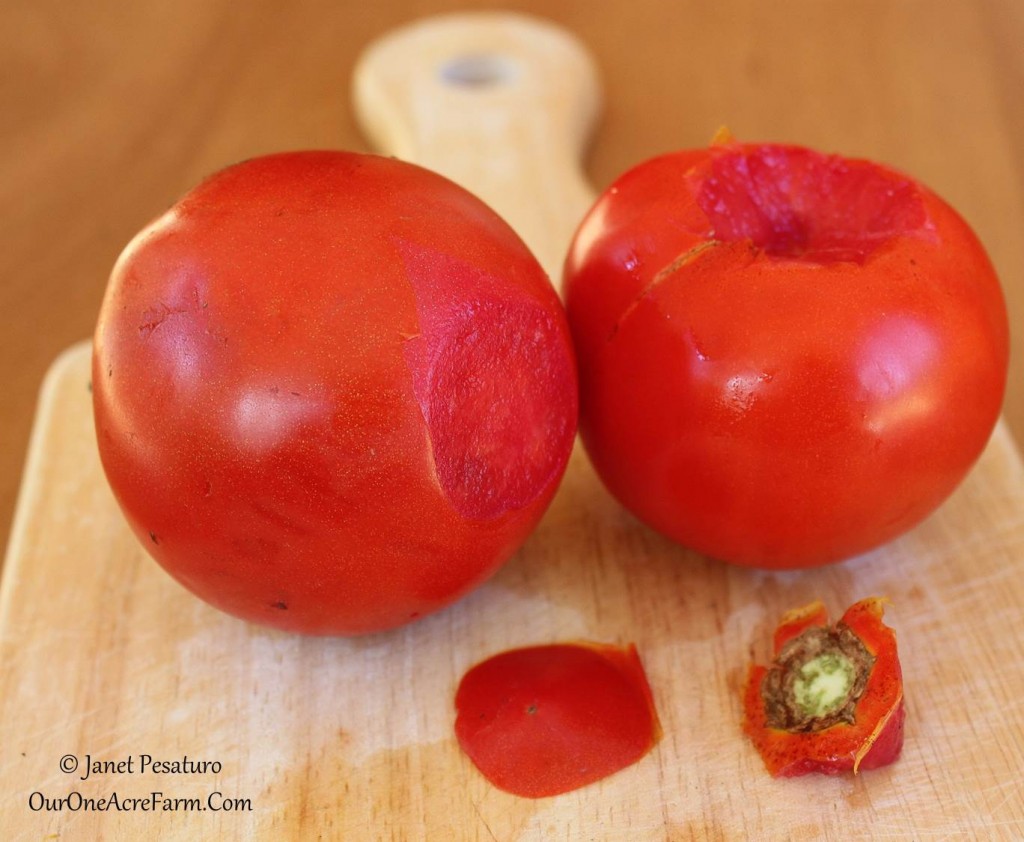
Before you slice the tomatoes, remove the stem scar, and cut and discard a thin slice from the other end.
3. Cut slices of the proper thickness
Cut the tomatoes into 3/8 – 1/2 inch thick slices. Thicker slices take too long to dry. Some people quarter them – I think it takes too long for them to dry. Some people skin them – I think it’s wasteful. It will be tempting to cut thinner slices, to reduce the drying time. But thinner slices have so little substance remaining when dry, that it’s hard to remove them from the tray.
4. Dry them at the appropriate temperature
Place the slices in single layer on the tray, and dry them at approximately 135 degrees F, whether using a dehydrator or the oven. (It will take about 8-10 hours, so if you plan to do a lot of dehydrating, you won’t want to tie up your oven for that long, and might want to invest in a dehydrator.)
Many people speed up the process by increasing the temperature, but studies suggest that this degrades the anti-oxidants and vitamin C (see sources at the end of this post).
If you live in a dry enough climate, you might want to dry them outside, to produce bona fide “sun-dried” tomatoes. It might take days, however. Read more about making truly sun-dried tomatoes here.
5. Know how to tell when they are done
Dry until slices are leathery or brittle, and still red. If they are leathery you should not be able squeeze a drop of water out of them. If you can, they are too moist and won’t keep as well. If you dry until they are brittle, you could, if you prefer, powder them in a blender to be used for sauce. Do not let them turn brown. Browning is correlated with a decline in the vitamin C and antioxidant levels.
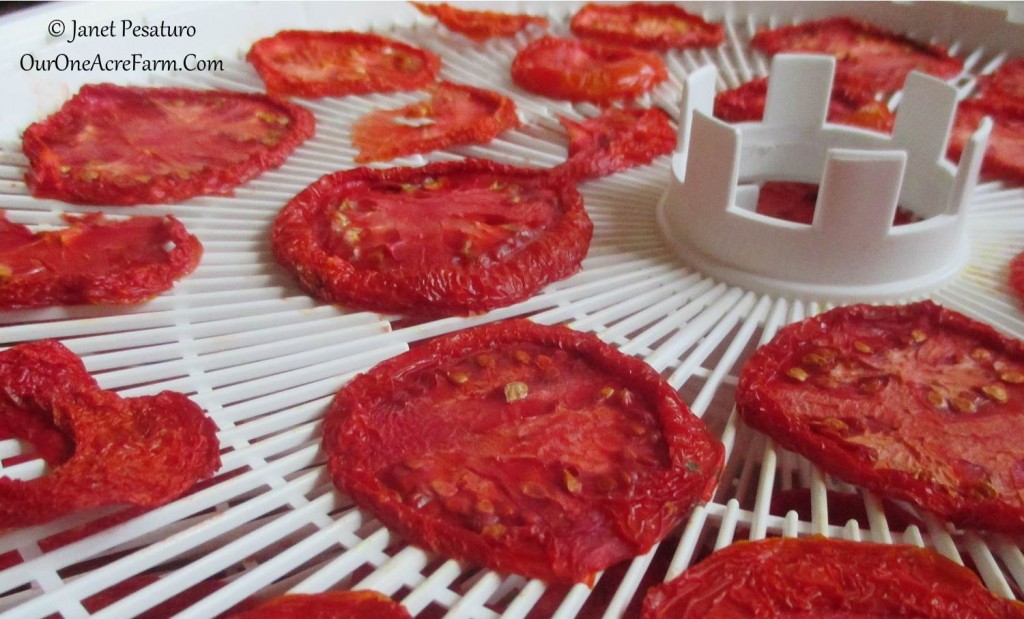
To test for doneness, squeeze the puffiest part of each slice. If you can squeeze a drop of water out, it’s not dry enough for safe storage.
6. Store dried tomatoes properly
Put dried slices (or powder) into an air tight container and store in refrigerator or freezer. A vacuum packager is best, but I don’t have one, so I put the slices in ziploc bags, squeeze out the air, and seal the bag. The colder the storage temperature, the longer the shelf life, so I store them in the freezer.
Want to learn how to safely dry tomatoes with oil, garlic, and herbs? Read about it here.
Additional sources
- Kerkhofs et al., Change in Colour and Antioxidant Content of Tomato Cultivars Following Forced-Air Drying. 2005. Plant Foods for Human Nutrition 60: 117-121.
- Marfil et al. Ascorbic Acid Degradation Kinetics in Tomatoes at Different Drying Conditions. 2008. Swiss Society of Food Science and Technology. 41:9, 1642-1647.
And so, dear reader, you deserve a medal for making it this far. Now if you’ll excuse me, I’ll move right along to my next crucially important magnum opus: 47 tips for making a perfect peanut butter and jelly sandwich.
What’s your favorite way to preserve tomatoes?
Shared on: Homestead Barn Hop, Thank Goodness It’s Monday, Backyard Farming Connection, Tuesdays with a Twist











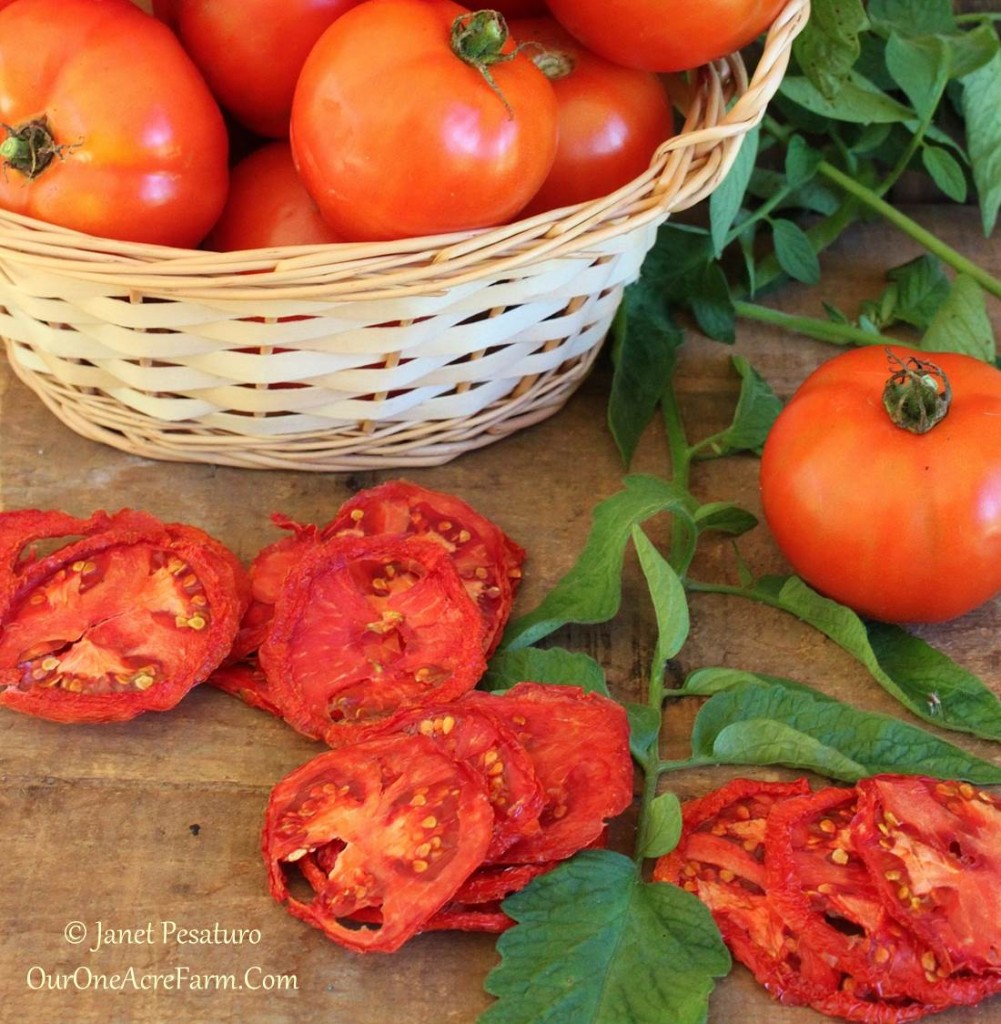
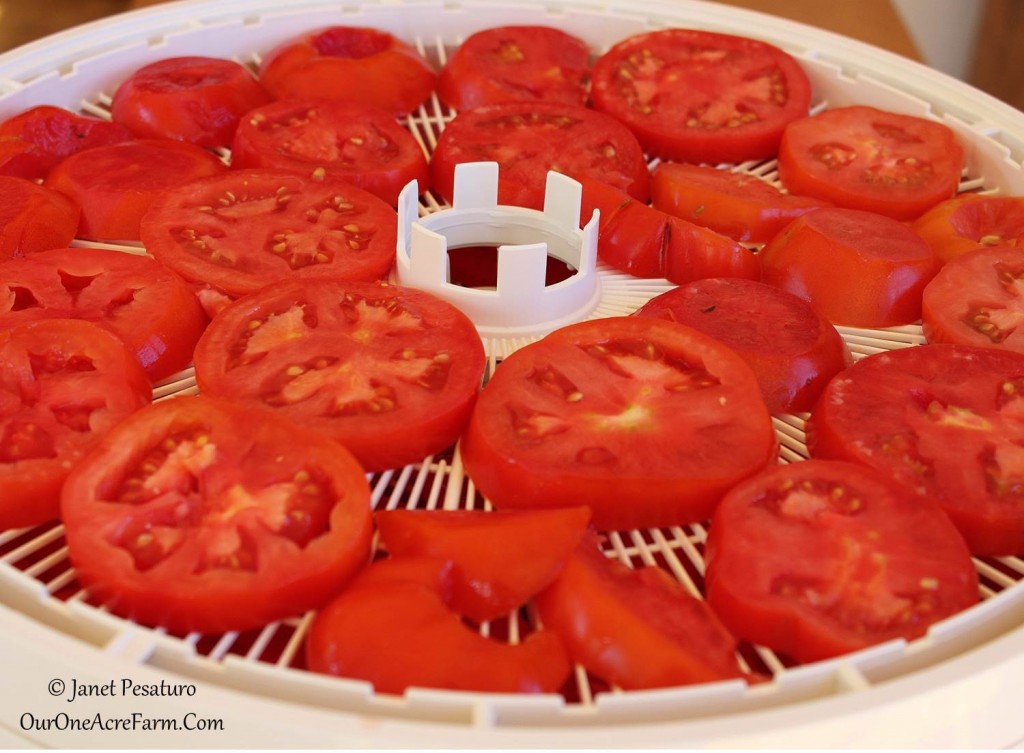
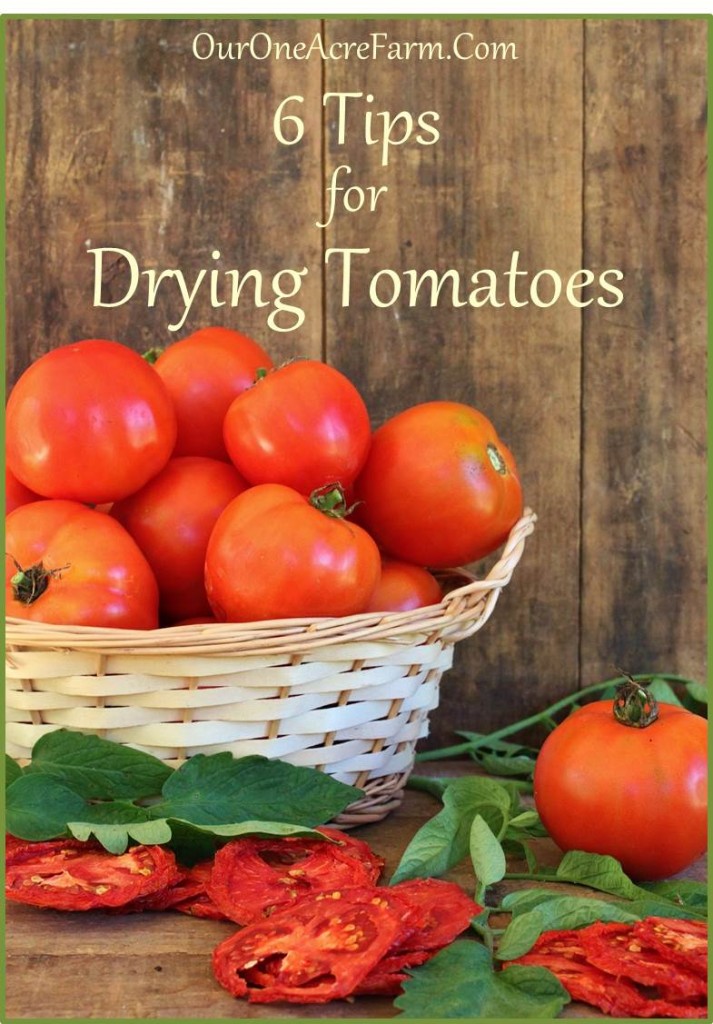
It is super easy, but the tips are helpful so thank you!
My pleasure, Heather!
Right now, we are just drying them in our car where it gets 140 degrees easy with one window cracked. Put them up in the dash and then we usually finish them off the next day in the sun. I don’t have the energy to use a dehydrator but next year we are going to build a solar dehydrator.
Well, Zachary, you are an inspiration. It never occurred to me to dry them inside the car, that is a great idea. Although here it gets so humid (as it is today), that I’m not sure how well it would work. Love the idea of a solar dehydrator. More power to ya!
Great article! I would like to start dehydrating garden produce, but I have only canned and frozen up to this point. Maybe I can finagle a dehydrator for Christmas?
Stopped by from the Titus 2sDays Blog Hop!
Thanks, Jan! You can dehydrate in your oven, but it helps to have a dehydrator because oven drying ties up the oven for a long time. I do love mine!
Janet, I would love to see picstures of your one acre farm. I live in southeast Georgia and live on one acre also. I have chickens, but I would love to see how you laid out your yard,I have a small garden. But would like to expand it. Thanks
Janet, I would love to see pictures of your one acre farm. I live on one acre also. I have chickens and a very small garden 8×12. I would like to see how you laid out your farm. I live in southeast Georgia, it get hot here and can get rather cold in the winter. Any help would be appreciated. Thanks
Hi Trudie! Funny you ask, because I’m preparing for a future post on predator friendly chicken farming, showing how things are laid out here, complete with a diagram. It probably won’t be for a couple months, though, because I’m waiting for my Certified Predator Friendly application to get approved (the post is going to discuss their requirements)
We did everything little by little here, and some things worked out well while other things didn’t. We were constrained by location of the well and septic field, and some big trees that cast a lot of shade. So I’m not sure how much it will help you to see how we laid it all out, but hopefully by sometime in November, I will finish that post.
Thanks for asking!
Pingback: My Week on Wednesday… September 3 » Once Upon a Time in a Bed of Wildflowers
I love this post so informative! I’ll be featuring it this at Garden up green on Tuesdays with a twist #75 this week. Hope you stop by and link up.
Carole at Garden Up green
Thanks, Carole!!
Great tips on drying tomatoes! I am a big fan of dehydrating them. We like to vacuum seal them and keep in the freezer. They are so useful in the kitchen too.
Thanks, Dave! I wish we had a vacuum sealer – that’s next on my list!
Pingback: How To Pressure Can Green Beans | The Flip Flop Barnyard
Pingback: Honey Spiced Dried Apple Rings - One Acre Farm
Pingback: Excalibur Dehydrator Giveaway - One Acre Farm
Pingback: Fall Giveaway Extravaganza #3: Win an Excalibur Dehydrator | The Easy Homestead
Pingback: How to Start a Backyard Farm - One Acre Farm
Pingback: How to Preserve Strawberries - One Acre Farm
My tomatoes normally come out perfect the way i like. However – today I lost 50 dollars worth of tomatoes :(. I’m unsure what happened, but i may have an idea! I use the eight tray garden master dehydrator – never an issues. Today my new tray came in – I went fro 8 trays to thirty per unit. The garden master is supposed to expand to 30 trays. Anyway – I set to 135 as i always do. They came out black, 🙁 i lost all the tomatoes. I dont understand what happened – most came out black and many also still not dehydrated and red. I felt the spacing was fine with the tomatoes. so Im lost and confused what happened. Any ideas? Thank you in advanced. the tomatoes were 1/4 sliced.
50.00 dollars is two bushels from the farm here locally.